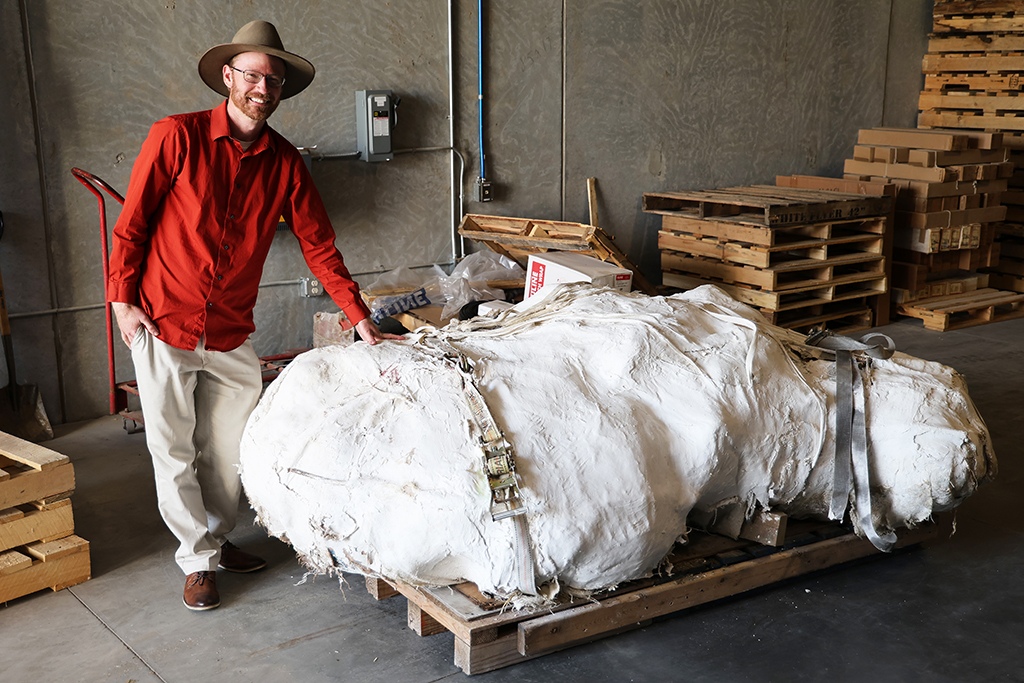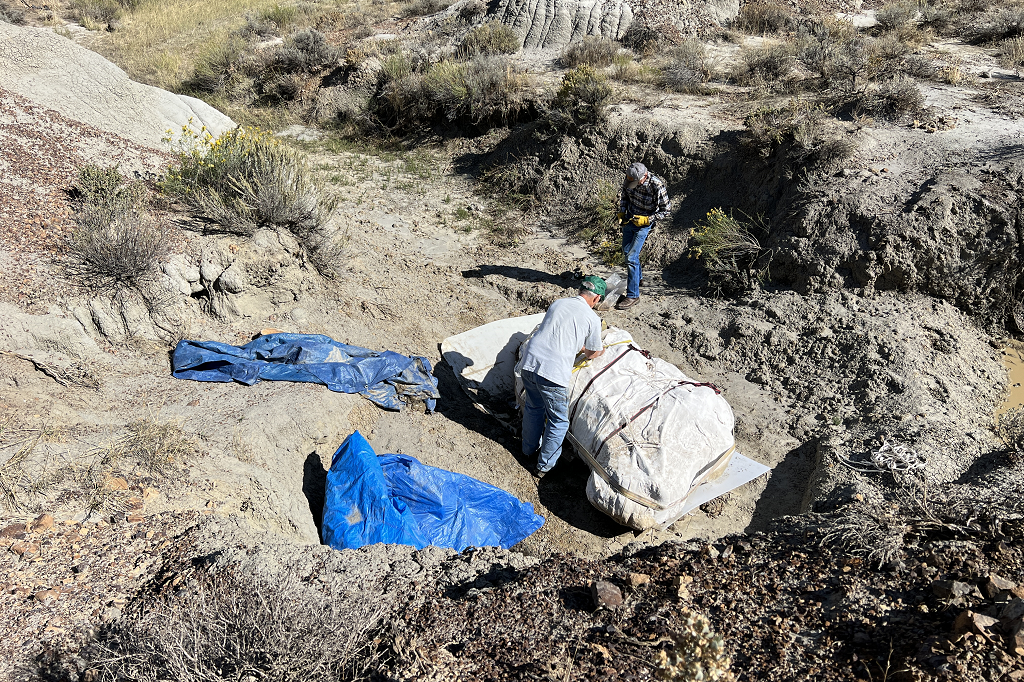Dinosaur fossil arrives at UND
Edmontosaurus specimen — found by team led by UND paleontologist — will be displayed at Leonard Hall

When one thinks of Edmonton, Alb., Wayne Gretzky and the five-time NHL champion Oilers may be the first topics that come to mind.
But the city is also the namesake of the Edmontosaurus, one of the largest plant-eating dinosaurs to ever roam North America. That’s because remains of the species were first discovered in 1917 in sandstones of the Horseshoe Canyon Formation in southwestern Alberta.
Earlier this month, a team led by Paul Ullmann, an assistant professor of paleontology in UND’s Harold Hamm School of Geology and Geological Engineering, returned to campus with a new Edmontosaurus specimen consisting of approximately 25 bones and weighing 4,400 pounds – a find that greatly pleased Ullmann and his team.
“Anything better than two bones is a wonderful find,” he said.
Bringing the specimen to UND was an immense undertaking and team effort, in which Ullmann was assisted by College of Engineering and Mines’ Facilities and Equipment Manager Darin Buri, UND mechanical engineering alum Gerald Voegele (‘81), and staff from Ironman Welding in East Grand Forks.
A giant of the hadrosaur or “duck-billed” family of dinosaurs, a fully grown adult Edmontosaurus could reach upwards of 40 feet in length, comparable in size to carnivorous dinosaurs such as the Tyrannosaurus Rex.
“There have been cases where you find one of these hadrosaurs, and it’s so large you may think you have a T-Rex,” Ullmann said. “Then you find more diagnostic bones that show you it’s a plant eater, not a carnivore.”
The specimen was found near Jordan, Mont., in the Hell Creek Formation, a suite of rocks famous for the study of dinosaurs of the cretaceous period. Ullmann estimates the new specimen to be 67 million years old.

As evidenced by previous bone discoveries, Edmontosaurus was a gregarious species, congregating in herds of several hundred.
“There’s a butte I worked at in South Dakota for my doctorate research, and there are (Edmontosaurus) bones sticking out of a horizon about a foot-and-a-half thick all the way for half a mile,” Ullmann said.
After the specimen was discovered in June 2019 by Steve Adamek, a geologist with Fargo-based Dakota Technologies, the excavation process involved four years of intricate work.
“The first year he found it we did not get to do a whole lot, because it was found, as it always goes, on one of the last days of the field season,” Ullmann said. “We had to just cover it and leave it. We weren’t out there in 2020 because of the pandemic, so 2021 was our big collaborative excavation unveiling this specimen.”
Once excavated and encased in plaster, it took the team 10 hours to pull the specimen up a 100-foot hill and load it onto a trailer for transport back to Grand Forks.

The excavation also gave several students from Northern Cass High School in Hunter, N.D., a chance to gain hands-on experience in the field.
“It’s awesome,” Ullmann said. “I’ve been working with a science teacher there for years – Mr. Christian Thompson – and for the last three years, he has brought five to six of his students for a week of field experience, and they’re an integral help to the team as much as the college students are. They learn a lot, and they have found a lot – we find a lot of Triceratops in addition to Edmontosaurus. It’s a wonderful experience.”
Ullmann said the expedition was funded in part by an anonymous donor, as well as internally through partnerships with Concordia College and Rowan University, located in Moorhead, Minn., and Glassboro, N.J., respectively. He and his team are applying for further grants to support future expeditions to the area and other dinosaur-bearing badlands in North Dakota.
The specimen is currently housed in the North Dakota Geologic Survey’s Wilson M. Laird Core and Sample Library, encased in 10 protective layers of plaster and burlap, which Ullmann likened to a cast, further reinforced with rebar. After it is removed from its protective coating – a process that may take up to a month – the bones will be examined more thoroughly to determine their geochemistry and whether they contain original soft tissues, such as blood vessels and bone cells. Such research can provide vital insights into the dinosaur’s habitat and physiology.
“Recovery of soft tissues, cells and molecules from such ancient fossils is right at the forefront of paleontology,” Ullmann said. “It’s only since 2005 that we’ve recognized that those seemingly fragile components can still be there in fossil bones. My collaborators at North Carolina State University and several other teams around the world have used molecular data out of such cells and soft tissues to test how dinosaurs were related to other animals, independent of their skeletal anatomy. We are trying to make big steps in that direction as we investigate more specimens over the years.”
Despite the clues they may provide, Ullmann jokingly dispelled any notion of cloning dinosaurs through molecules recovered from fossil soft tissues or bone cells.
“Anytime you have molecules and dinosaurs in the same sentence, it gets brought up,” he said. “But, as fun as it is, Jurassic Park is still science fiction.”

By MCDinosaurhunter – Own work, CC BY-SA 3.0, https://commons.wikimedia.org/w/index.php?curid=33465209
The bones will be stabilized and cleaned for display at Leonard Hall in a process called fossil preparation, which Ullmann said is likely a “two-to-three-year project, if not more.” Fossil preparation will also provide a novel opportunity for UND students and members of the community to work together.
“In the past when I’ve run fossil preparation shifts at other universities, we’ve had a lot of interest from retirees who have been going back to their passions,” he said. “Getting the UND students in with retirees would be a fun mix – the inevitable result is fun conversations about life experiences interspersed with questions like ‘tell us about what you’re doing in your classes.’”
Ullmann will begin teaching at UND this upcoming spring semester with a course titled “GEOL 105 Special Topics: Discovering Dinosaurs.” The course does not have any prerequisites and is open to students of all majors.
After being the focus of several avenues of research and a period of display at Leonard Hall, the specimen’s final home will be the Museum of the Rockies in Bozeman, Mont., the required destination of all specimens discovered on Montana state land, according to Ullmann.



